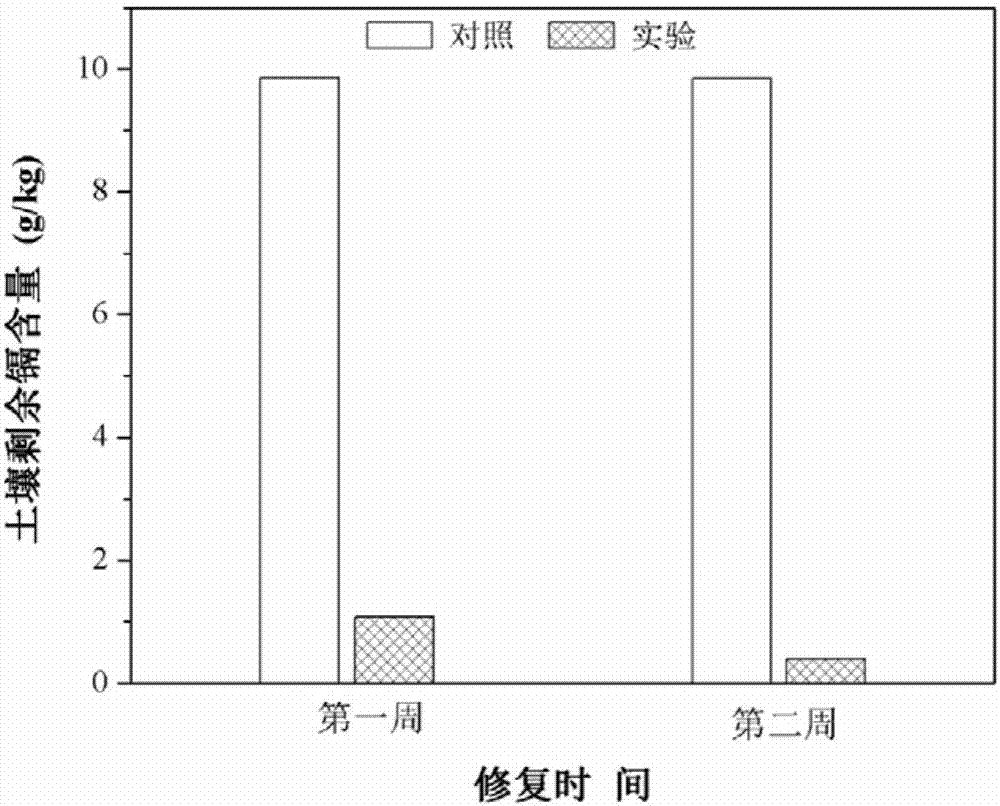Application of carbonate-mineralization microbe in decreasing content of effective-state cadmium in soil and method
A technology of mineralizing bacteria and carbonate, applied in the field of resources and environment, can solve the problems of complex remediation and treatment operations, high remediation costs, soil cadmium pollution, etc., and achieves the effects of low cost, strong tolerance and simple operation.
- Summary
- Abstract
- Description
- Claims
- Application Information
AI Technical Summary
Problems solved by technology
Method used
Image
Examples
Embodiment 1
[0058] Example 1 Isolation and identification of strains
[0059] The heavy metal-contaminated soil in the mining area was collected, and pure single bacteria were obtained by using a specific selection medium for repeated streaking and isolation.
[0060] Among them, selection medium (g / L): yeast extract 10, NH 4 Cl 20, anhydrous sodium acetate 8.2, urea 40.4, deionized water. Urea and ammonium chloride were sterilized by filtration with a 0.22-micron filter membrane, and the remaining components were sterilized at 121°C for 20 minutes under high pressure and high temperature. Identification medium (g / L): peptone 10, beef extract 3, urea 40.4, sodium chloride 5, agar powder 15, 1.6% bromocresol purple 2, deionized water. The urea and bromocresol purple solutions were sterilized by filtration, and the remaining components were sterilized by autoclaving at 121°C for 20 minutes. Finally, 2mol / L NaOH solution was used to adjust the pH of the medium to 5.75. LB medium (g / L): p...
Embodiment 2
[0064] Example 2 Soil remediation
[0065] Inoculate the sterilized 100mL LB medium with the strain provided in Example 1, shake and culture at 25°C for 24 hours, measure the OD value of the bacterial solution with an ultraviolet spectrometer, and ensure that the OD value of the bacterial solution is consistent with the soil before mixing. Dilute the bacterial solution to OD value = 1.5 and set aside.
[0066] Take 500g of soil with a cadmium content of 10mg / kg, air-dry it naturally, grind it through a 20-mesh sieve, and mix it with the cultured bacterial solution and urea. The mass ratio of urea, bacterial solution and soil is 0.05:1:5, that is, take 100g of solution, 500g of soil to be repaired, added 5g of urea, stirred evenly and cultured at 25°C, and the soil moisture content was maintained at 35% during the test. Set up a blank group and a control group, where the blank group refers to the campus soil without adding cadmium solution, maintaining a moisture content of 35...
Embodiment 3
[0067] The mensuration of embodiment 3 cadmium content
[0068] After 7 days and 14 days of restoration culture, the TCLP method was used to measure the effective content of Cd in the soil before and after treatment, respectively. In this embodiment, the buffer solution was selected to detect the test samples. Among them, the configuration method of buffer solution is: 5.7mL glacial acetic acid is dissolved in distilled water, use 1L volumetric flask to constant volume, 1M HNO 3 and 1M NaOH were used to adjust the pH of the buffer so that the pH was 2.88±0.05. Mix the buffer solution with the repaired soil, the mass ratio of the buffer solution to the soil is 20:1, shake and react for 18 hours under the condition of 30±2r / min, centrifugal filter, and use ICP to measure the cadmium concentration in the supernatant. The result is as figure 1 with figure 2 Shown, wherein, monomeric urease activity (SUA) refers to the urease activity of bacterial strain under the unit OD value...
PUM
 Login to View More
Login to View More Abstract
Description
Claims
Application Information
 Login to View More
Login to View More - R&D
- Intellectual Property
- Life Sciences
- Materials
- Tech Scout
- Unparalleled Data Quality
- Higher Quality Content
- 60% Fewer Hallucinations
Browse by: Latest US Patents, China's latest patents, Technical Efficacy Thesaurus, Application Domain, Technology Topic, Popular Technical Reports.
© 2025 PatSnap. All rights reserved.Legal|Privacy policy|Modern Slavery Act Transparency Statement|Sitemap|About US| Contact US: help@patsnap.com


